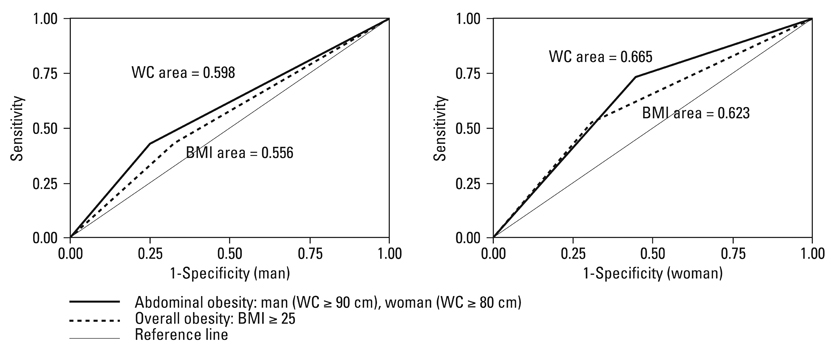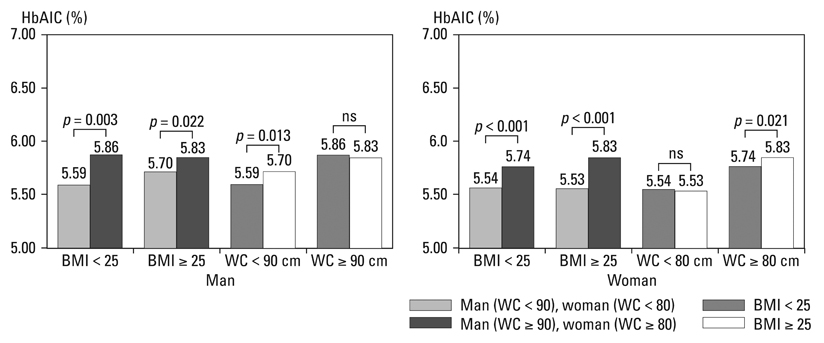Yonsei Med J.
2010 Nov;51(6):850-856. 10.3349/ymj.2010.51.6.850.
Sex Difference of Type 2 Diabetes Affected by Abdominal Obesity versus Overall Obesity
- Affiliations
-
- 1Department of Social Welfare, Baekseok University, Cheonan, Korea.
- 2Department of Preventive Medicine, Ajou University School of Medicine, Suwon, Korea. ajoujkh@ajou.ac.kr
- KMID: 1779630
- DOI: http://doi.org/10.3349/ymj.2010.51.6.850
Abstract
- PURPOSE
This research compares the predictive value of the abdominal obesity indicator, waist circumference (WC), and the overall obesity indicator, body mass index (BMI), among men and women with regard to type 2 diabetes.
MATERIALS AND METHODS
This study used data collected from 4,400 households selected by a stratified multistage probability sampling method during the 2001 Korea National Health and Nutrition Examination Survey (KNHANES). The final study sample included 4,684 subjects over 30 years of age who had completed the health examination required for the analysis of the health interview and health behavior surveys.
RESULTS
Both men and women showed significant differences in fasting blood glucose (FBG) or HbA1c levels based on abdominal obesity irrespective of BMI. However, the presence of overall obesity among men with abdominal obesity was not significantly correlated with FBG or HbA1c levels, while the presence of overall obesity among women with abdominal obesity was significantly different in regard to FBG or HbA1c levels.
CONCLUSION
Both WC and BMI emerged as a measures of risk factors for type 2 diabetes among women while only WC emerged as a risk factor for diabetes among men.
Keyword
MeSH Terms
-
Adult
Blood Glucose/*analysis
Body Mass Index
Diabetes Mellitus, Type 2/*drug therapy
Female
Health Behavior
Hemoglobin A, Glycosylated/metabolism
Humans
Insulin/*administration & dosage/*therapeutic use
Male
Middle Aged
Nutrition Surveys
Obesity/blood/*complications
Obesity, Abdominal/blood/*complications
ROC Curve
Republic of Korea
Figure
Reference
-
1. Rimm EB, Stampfer MJ, Giovannucci E, Ascherio A, Spiegelman D, Colditz GA, et al. Body size and fat distribution as predictors of coronary heart disease among middle-aged and older US men. Am J Epidemiol. 1995. 141:1117–1127.
Article2. Carey VJ, Walters EE, Colditz GA, Solomon CG, Willett WC, Rosner BA, et al. The Nurses' Health Study. Body fat distribution and risk of non-insulin-dependent diabetes mellitus in women. Am J Epidemiol. 1997. 145:614–619.
Article3. Wei M, Gaskill SP, Haffner SM, Stern MP. Waist circumference as the best predictor of noninsulin dependent diabetes mellitus (NIDDM) compared to body mass index, waist/hip ratio and other anthropometric measurements in Mexican Americans--a 7-year prospective study. Obes Res. 1997. 5:16–23.
Article4. National Cholesterol Education Program (NCEP) Expert Panel on Detection, Evaluation, and Treatment of High Blood Cholesterol in Adults (Adult Treatment Panel III). Third Report of the National Cholesterol Education Program (NCEP) Expert Panel on Detection, Evaluation, and Treatment of High Blood Cholesterol in Adults (Adult Treatment Panel III). JAMA. 2001. 285:2486–2497.5. Després JP, Nadeau A, Tremblay A, Ferland M, Moorjani S, Lupien PJ, et al. Role of deep abdominal fat in the association between regional adipose tissue distribution and glucose tolerance in obese women. Diabetes. 1989. 38:304–309.
Article6. Poirier P, Lemieux I, Mauriége P, Dewailly E, Blanchet C, Bergeron J, et al. Impact of waist circumference on the relationship between blood pressure and insulin: the Quebec Health Survey. Hypertension. 2005. 45:363–367.
Article7. Tulloch-Reid MK, Williams DE, Looker HC, Hanson RL, Knowler WC. Do measures of body fat distribution provide information on the risk of type 2 diabetes in addition to measures of general obesity? Comparison of anthropometric predictors of type 2 diabetes in Pima Indians. Diabetes Care. 2003. 26:2556–2561.
Article8. Ford ES, Mokdad AH, Giles WH. Trends in waist circumference among U.S. adults. Obes Res. 2003. 11:1223–1231.
Article9. Sargeant LA, Bennett FI, Forrester TE, Cooper RS, Wilks RJ. Predicting incident diabetes in Jamaica: the role of anthropometry. Obes Res. 2002. 10:792–798.
Article10. Wang Y, Rimm EB, Stampfer MJ, Willett WC, Hu FB. Comparison of abdominal adiposity and overall obesity in predicting risk of type 2 diabetes among men. Am J Clin Nutr. 2005. 81:555–563.11. Seidell JC, Kahn HS, Williamson DF, Lissner L, Valdez R. Report from a Centers for Disease Control and Prevention Workshop on use of adult anthropometry for public health and primary health care. Am J Clin Nutr. 2001. 73:123–126.
Article12. Ledoux M, Lambert J, Reeder BA, Després JP. Canadian Heart Health Surveys Research Group. Correlation between cardiovascular disease risk factors and simple anthropometric measures. CMAJ. 1997. 157:Suppl 1. S46–S53.13. Reeder BA, Senthilselvan A, Després JP, Angel A, Liu L, Wang H, et al. Canadian Heart Health Surveys Research Group. The association of cardiovascular disease risk factors with abdominal obesity in Canada. CMAJ. 1997. 157:Suppl 1. S39–S45.14. Paek KW, Chun KH, Jin KN, Lee KS. Do health behaviors moderate the effect of socioeconomic status on metabolic syndrome? Ann Epidemiol. 2006. 16:756–762.
Article15. Rankinen T, Kim SY, Pérusse L, Després JP, Bouchard C. The prediction of abdominal visceral fat level from body composition and anthropometry: ROC analysis. Int J Obes Relat Metab Disord. 1999. 23:801–809.
Article16. Seidell JC, Pérusse L, Després JP, Bouchard C. Waist and hip circumferences have independent and opposite effects on cardiovascular disease risk factors: the Quebec Family Study. Am J Clin Nutr. 2001. 74:315–321.
Article17. Hill JO, Sidney S, Lewis CE, Tolan K, Scherzinger AL, Stamm ER. Racial differences in amounts of visceral adipose tissue in young adults: the CARDIA (Coronary Artery Risk Development in Young Adults) study. Am J Clin Nutr. 1999. 69:381–387.
Article18. American Heart Association. Heart and stroke facts. 1992. Dallas: American Heart Association.19. US Department of Agriculture. Dietary guidelines for Americans. 1990. Washington, DC: US Department of Agriculture, Publication;261–495. 2012420. Zhu S, Wang Z, Heshka S, Heo M, Faith MS, Heymsfield SB. Waist circumference and obesity-associated risk factors among whites in the third National Health and Nutrition Examination Survey: clinical action thresholds. Am J Clin Nutr. 2002. 76:743–749.21. Ardern CI, Janssen I, Ross R, Katzmarzyk PT. Development of health-related waist circumference thresholds within BMI categories. Obes Res. 2004. 12:1094–1103.
Article22. Kuczmarski RJ, Carroll MD, Flegal KM, Troiano RP. Varying body mass index cutoff points to describe overweight prevalence among US adults: NHANES III (1988 to 1994). Obes Res. 1997. 5:542–548.
Article23. Kaye SA, Folsom AR, Sprafka JM, Prineas RJ, Wallace RB. Increased incidence of diabetes mellitus in relation to abdominal adiposity in older women. J Clin Epidemiol. 1991. 44:329–334.24. Chan JM, Rimm EB, Colditz GA, Stampfer MJ, Willett WC. Obesity, fat distribution, and weight gain as risk factors for clinical diabetes in men. Diabetes Care. 1994. 17:961–969.
Article25. Rexrode KM, Carey VJ, Hennekens CH, Walters EE, Colditz GA, Stampfer MJ, et al. Abdominal adiposity and coronary heart disease in women. JAMA. 1998. 280:1843–1848.
Article
- Full Text Links
- Actions
-
Cited
- CITED
-
- Close
- Share
- Similar articles
-
- Effects of Obesity Type on Diabetes and Hypertension in Obese Korean Adults
- The Effects of Abdominal Obesity on the Increased Prevalence Rate of Hypertension and Diabetes Mellitus in Benign Prostatic Hyperplasia Patients
- Effect of Visceral Obesity for Patients with Type 2 Diabetes Mellitus
- Pharmacological Management of Obesity in Patients with Type 2 Diabetes: An Update
- Changes in Abdominal Obesity Affect the Risk of Metachronous Advanced Colorectal Neoplasia Development after Polypectomy




